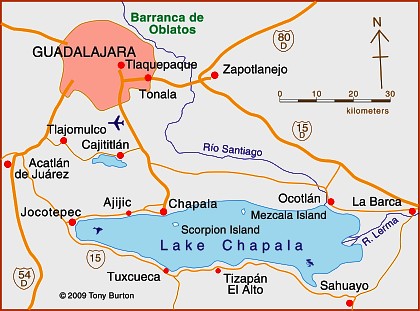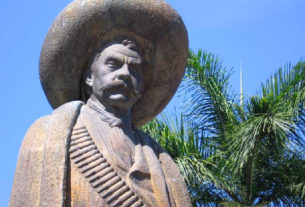Did You Know…?
In the nineteenth century, prior to the advent of the railroads, overland travel was decidedly slow and arduous. To get to Lake Chapala, for example, from Guadalajara usually entailed either an overnight stop en route, or a full day’s travel, with a change of horses mid-way. It is hardly surprising, therefore, that relatively few people braved the uncertainties of the trip (and the bandits regularly encountered outside the large cities) to visit Chapala or Ajijic.
The potential for waterbourne trade from Salamance and Celaya (both on the River Lerma) to the port of San Blas, at the mouth of the River Santiago, via Lake Chapala, had been recognised at the start of the century by none other than the brilliant Prussian scientist Alexander von Humboldt. Following Mexico’s independence in 1821, Mexican entrepreneurs devised several schemes to improve navigation in the Lerma-Chapala-Santiago system.
For instance, in 1833, the then governor of Jalisco, Pedro Tamés, planned to make much of the river navigable while bringing water via a canal from the River Santiago at Poncitlán to a mill in Guadalajara. The engineer who looked at the proposal, Samuel Trant, agreed that the plan was feasible, and prepared a detailed map of the best route, but Tamés left office shortly afterwards, and the plan was shelved.
In December 1865 the Compañia de Navegación y Comercio del Lago de Chapala y Río Grande (Company for Navigation and Commerce on Lake Chapala and the River Santiago) was formed. Its stated aims were to purchase boats, canalise the river to make it navigable, and build warehouses and other infrastructure for commerce. Promotional brochures included a detailed map showing the anticipated commercial sphere of influence of the project. These plans were never fulfilled either, perhaps because prospective French investors pulled out when Maximilian was deposed.
Even if a canal could not be built, other businessmen were convinced that steamboats could provide a valuable service on Lake Chapala, linking towns that were difficult to reach by road much more quickly than could be done on horseback or by stage coach. Finally, in 1868, the Compañía de Navegación por Vapor en el Lago de Chapala (Lake Chapala Steamboat Company) was formed, and the steamboat Libertad (Freedom) was launched on the lake. The company’s director was Mr. Duncan Cameron, referred to in an 1872 book when Georgina Kingsley wrote that one of her party left on, “a little steamer belonging to Mr. C, an enterprising American, who runs it once a week from Chapala, at the western end, to La Barca.”

It was a wonderful old tub, evidently built in the days when shipbuilding was in its infancy, judging from its uncouth shape and old timbers, that creaked at every movement of the paddles. Our voyage took in several villages round the lake. At each stopping place we would land on the little mud jetties to suck a piece of sugar-cane or quaff a festive glass of tequila.
Unfortunately, by the time St. Hill’s book was published in 1892, he needed to add news of a tragic event:
At one of the villages a sad accident has since occurred; the crazy old steamer toppled over with her living freight of over two hundred passengers just as she reached the landing-stage, nearly all being drowned. One heroic American, employed on the Central Railroad, who was on board at the time, succeeded in saving the lives of sixteen by his pluck and great swimming powers.
The Libertad capsized at Ocotlán, only six meters from shore, on Sunday March 24, 1889; 28 people were drowned. The American referred to was the Railway Superintendent, a Mr. C.E. Halbert. The state government later decorated several people for saving lives and five “gallant Americans” – C. E. Halbert, C. E. Shackford, L. Rosenthal, H. R. Cornforth and Joseph H. Feehan – were also decorated in the U.S. for their bravery at the disaster scene.
The following year, the Libertad was refloated, and renamed Ramón Corona, for the state governor. In November 1889, Ramón Corona was assassinated. The boat was taken to Lake Patzcuáro and renamed the Don Vasco.
The Libertad was not the only steamship on the lake. In 1893, Thomas Rogers describes a newer vessel, which has two decks:
The steamer “Chapala” is a flat-bottom stern-wheel boat, very like those that are common on the shallow rivers of the West; the only boats adapted to shoal-water service. Everything about the steamer appears new, but one of the things not new on the “Chapala” is Juan Perez, the pilot. He is not necessarily old, but he is a veteran in service…
A Mexican writer, Eduardo Gibbon, writing at the time, also refers to the Chapala, which he describes as being 80 feet in length by 20 wide, drawing only three feet of water, and used for both passengers and cargo. Gibbon himself took at least one trip on yet another steamboat, the San Francisco, which appears to have been normally used only for cargo on “regular daily voyages between Ocotlán, La Barca and Tizapán.”
Despite their success, by the dawn of the twentieth century, the days of steamers on the lake were becoming numbered as first the train, and then the automobile, became the preferred mode of transport. Just as the village of Chapala and its spa waters began to attract international attention, sailboats replaced steamboats and reclaimed the lake.



My name is Dan Loweree from El Paso, Texas. I am a descendant of the Loweree brothers who ran the Vapor Chapala in the 1880s. I was wondering if you had any information or photos of them.
Daniel, Thanks for reaching out, but I doubt I’m going to be of much help.
The brothers were the four younger sons of U.S. businessman Daniel D. Loweree (1799–1868) and his wife Nancy Ana Howell (?-1863), both of whom died in Guadalajara. All four sons – Francis H. B. Loweree Howell (1833–1881), Robert George Loweree Howell (1831–1882), Edward Green Loweree Howell (1836-1904) and James Armour Loweree Howell (1838–1880) – were born in the U.S. In Mexico, they were known as Francisco, Roberto, Santiago and Eduardo Loweree.
According to documents in the municipal archive of Chapala, restoration work of the “Libertad” (following the tragedy of 1878) was undertaken by Roberto Loweree and his brothers. Work began in February 1880 and continued into the following year.
The “Chapala” (an entirely different vessel) was launched by Manuel Capetillo and his wife Josefa on 30 July 1881.
By 1884, Loweree Hermanos, advertising as “Empresa de Navigación por Vapor en el Lago de Chapala y Río Lerma,” was promoting the steamer “Chapala”, in combination with stagecoaches and the Mexican Central Railroad, as the fastest and most comfortable way to travel between Mexico City and Guadalajara.
The major enterprise of the company “Loweree Hermanos” was as owners of the Río Blanco textile factory in Zapopan, Jalisco. Loweree Hermanos ran into financial difficulties and was forced to sell the factory in 1885 (by which time most of the brothers had died).
Regards,
Tony